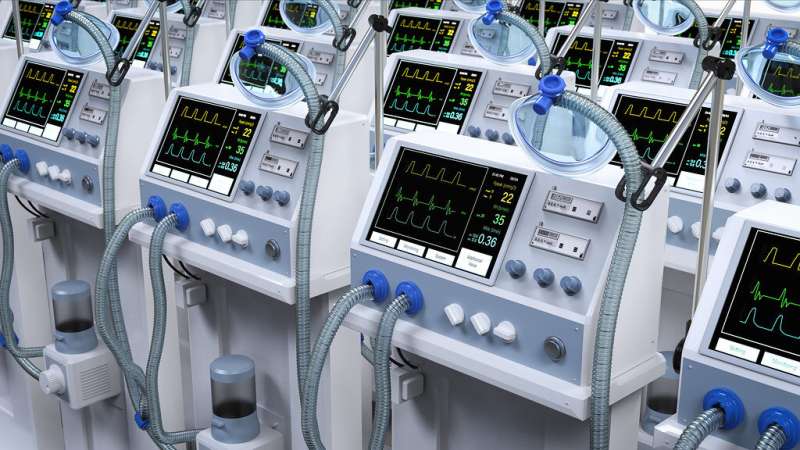
The COVID-19 pandemic has seen hardware developers clamoring to make ‘open source’ technology to support our frontline services. Their intentions have been honorable—an invitation to teams across the world to collaborate in developing essential equipment such as ventilators, thereby making the process of producing critical instruments more effective, both in time and cost.
In practice, however, most developers of hardware have shown little ‘openness’ in their sharing of designs, a fact lamented by a group of physicists from the University of Bath in the UK, in a paper published this week in The Design Journal.
According to the group, the pandemic has highlighted serious flaws in a system that forces research groups around the world to start from scratch every time a tweak needs to be made to an existing instrument, simply because they can’t get their hands on the original designs.
“The term ‘open source’ is being applied to the final design of an instrument—and I’m pleased to say there has been a willingness during the pandemic to share these final designs—but the design process itself also needs to be open, something it isn’t now,” explains physics researcher Dr. Julian Stirling.
Dr. Stirling uses a fictional scenario to describe the problem with the current model of open design: “Alice, a university researcher, gets public funding to create a new type of microscope, the NewScope. She spends two years developing this instrument and eventually gets it working.
A paper is published describing the principles behind her microscope, but the designs themselves are sold to a company. From these designs, the company produces the Fab NewScope. The instrument is popular with scientists and they are happy to buy it.
“Then Bob, another researcher, has an idea that will improve the Fab NewScope, and he gets public funding to make these improvements. But he doesn’t have access to the designs for the NewScope, so he has to start from scratch. Bob spends two years creating his improved NewScope, 18 months of which are spent redesigning the original microscope. He makes most of the same mistakes as Alice and goes down many of the same dead ends.
“Eventually, the NewScope+ is complete and a paper describing the principles behind it is published, but the designs themselves are sold to a company. Some time later, Charlie has a great idea for improving NewScope+ and so the whole process of reinventing the NewScope starts again.”
Dr. Stirling believes complete openness is needed at every point in the design process, not least because hardware designs are generally generated by academics from public funds.
“If the public is funding a generation of knowledge, they should have access to it,” he says. “For a company to collect the data that comes from this public-funded knowledge and then patent it seems a bit perverse to me.”
During the pandemic, many large tech companies—including Amazon, Microsoft and IBM—have signed the Open COVID pledge in recognition of the need for them to apply every tool at their disposal to halt the pandemic and treat those affected. The pledge is to make intellectual property available free of charge where it can be put to use in the fight against Covid-19. Dr. Stirling welcomes this gesture of goodwill but he points out that the pledge is time-limited.
“So when the next pandemic hits, we’ll be back in the same situation.”
This year has seen a surge in the development of ventilators to treat those most severely affected by the Covid virus, and participants of the open-source pledge have showed willing in sharing their ventilator designs. However, as Dr. Stirling explains, for legitimate legal and liability reasons, many pledge signatories have adopted an open-when-finished model, meaning their final design plans are open for others to use but their engineering efforts happen behind closed doors, so remote teams aren’t able to collaborate in real time.
“There has been a proliferation of projects with teams across the world independently designing over a hundred mutually incompatible ventilators,” said Dr. Stirling. “This a huge amount of duplicated effort.”
Dr. Stirling believes the way forward is for universities to give more support to staff who wish to engage in open design. He also calls on governments to clarify the liability of individual teams contributing to open design, so researchers are more willing to share their ideas throughout the design process without fearing they could face a lawsuit if a manufacturer produces a malfunctioning product from their prototype design. He also highlights that the regulatory process may be a barrier for open-source designs, as a manufacturer is required to understand and explain why a device has been designed the way it has.
“Ultimately, it is a device not a design that gets certified. It has to be this way as you don’t want anyone manufacturing a ventilator—you want accredited trained professionals,” said Dr. Stirling. “If a manufacturer only sees your final design, how can they understand it enough to take legal responsibility? With an open design process, transferring this knowledge should be possible.”
For the past five years the same research group has worked on the design for an open-source microscope that is now being adapted by individuals and organizations around the world. The 3-D printed OpenFlexure Microscope is highly customisable, meaning it be can adapted for laboratory, school and home use. The project has evolved such that every step of the design process is openly available.
“The more we work in the open, the less time we waste re-explaining the same issues to collaborators. This body of knowledge about the design is so important for our Tanzanian collaborators as they work to develop the design into a certified medical diagnostic device.”